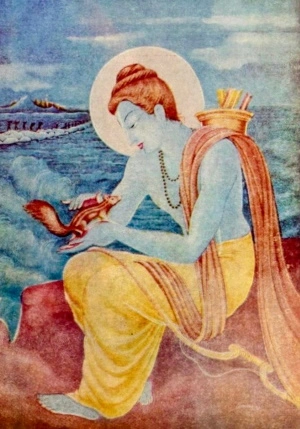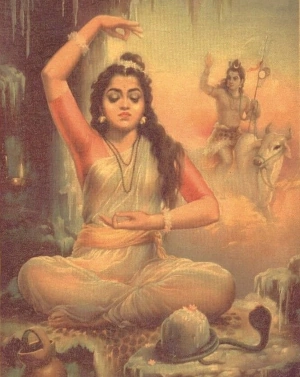How To Get Unlimited Happiness?
Listen to audio above

Transcript
(Click here to read more)
What is dharma for? To get happiness. There is no other purpose, other than this. When you say by observing dharma you can go to Swarga or Vaikuntha or Kailasa why should you go there in the first place? To be happy, to be perpetually happy. Not like how a dog becomes happy when you throw a biscuit in front of him. Waiting eagerly for the next biscuit to be thrown. That is a beggar’s life. Not that happiness. Our Sages realized that happiness is an internal experience. When you see something that you like, that makes you h....
Transcript
(Click here)
What is dharma for?
To get happiness.
There is no other purpose, other than this.
When you say by observing dharma you can go to Swarga or Vaikuntha or Kailasa why should you go there in the first place?
To be happy, to be perpetually happy.
Not like how a dog becomes happy when you throw a biscuit in front of him.
Waiting eagerly for the next biscuit to be thrown.
That is a beggar’s life.
Not that happiness.
Our Sages realized that happiness is an internal experience.
When you see something that you like, that makes you happy, like your favorite actor.
They realized that happiness is not in the eyes, it is somewhere inside you.
When you hear a song that you like, you become happy, happiness is not in the ears.
It is somewhere inside you.
So they experimented and found that to get that happiness inside, you don’t need what you see and what you hear even.
This happiness can be generated internally without the need for any external object.
Mind you, it is not imagining happiness.
It is real happiness.
It is not imagining that I am happy.
It is not an assertion that motivational speakers talk about.
This is real happiness.
This is like happiness that is contagious.
When you are happy, you are making others around you also happy.
This is real happiness.
A boy was getting pocket money of 50 rupees every day.
For that, he has to go and stand in front of his father every day.
His father will ask him so many questions:
How did you spend the money yesterday?
Why did you come late yesterday?
Why have you scored less in maths?
He will question him for 10 mins and then give that ten rupees.
One day, suddenly father tells him, take this card.
That is the debit card of the father’s account with crores and crores in it.
Take this card and take as much money as you want.
There is no restriction anymore, you don’t have to come and stand in front of me anymore.
What Sages realized was this.
When you can access that happiness without having to beg somebody, even your own eyes and ears, please give me some happiness, please give me some happiness.
You would be stupid not to do that, get that.
The Sages are so kind that they wanted everyone to benefit from this.
They devised small simple principles following which this huge account of happiness opens for you. You get the login id and password of that account.
These simple principles are dharma.
Observe them and in some time you get access to that huge happiness.
They tried to convey these principles to others in so many ways.
Some through hard statements, some through stories, some through poems.
I like reading serious books, you like children’s stories
Taste differs from person to person.
They conveyed these principles in so many different ways that everyone should benefit.
Now what Valmiki did was -
Before him, these principles and stories were scattered across so many scriptures, stories.
When you hear one you understand one thing, not everything.
Then by the time you hear the next one, probably the connectivity is lost.
You may not be able to connect them with each other.
So he thought, we need something that is linear, like a straight line.
From birth to death how a person should live following these simple principles.
Facing every conceivable situation in life which comes in everybody's life.
It should be like a ready reckoner that you can easily refer to and get your answers.
One book.
That anybody can refer to instantly and say: this is the situation, how should I behave if I want to get perpetual happiness.
But then what should be the content of that book?
Valmiki was very lucky.
He came to know that Lord Sri hari Paramatma had taken avatara and he was very much alive and around as the son of king Dasaratha of Ayodhya.
And he follows these principles unfailingly in every step of his life
To demonstrate to others how to achieve happiness in the easiest and most stable way..
They said that was the very purpose of his avatara.
Valmiki got his content.
He just described Rama’s life from beginning to end and he had the book the way he wanted.
This is Ramayana.
Recommended for you
Palani Temple

Learrn about the legend and greatness of the world famous Dandayuthapani Temple at Palani....
Click here to know more..The ananda called Sri Hari never ends
 Click here to know more..
Click here to know more..
Gauri Stuti

abhinava- nityaamamarasurendraam vimalayashodaam suphaladharitreem. vikasitahastaam trinayanayuktaam nayabhagadaatreem bhaja sarasaangeem. amri'tasamu....
Click here to know more..
English Topics
Ramayana
Click on any topic to open
- 50 Janaka's Spiritual Evolution - From Jnana to Bhakti
- 49 Dasharatha's Grief Decoded
- 48 Shiva burned Kamadeva at Chhapra, Bihar
- 47 Motherhood brilliance - Kausalya Supraja Rama
- 46 Bala and Atibala Mantras - Sriram Ji will unfold their superpower
- 45 Dasharatha Pleads With Vishwamtra Not To Take Away Young Sriram Ji
- 44 Abandoning Of Sita Devi - Is It Justifiable?
- 43 Vishwamitra Wants To Take Young Sriram Ji With Him
- 42 Position Of Sages In Ancient Bharata
- 41 Horoscope of Sriram Ji
Please wait while the audio list loads..
30
Ganapathy
Shiva
Hanuman
Devi
Vishnu Sahasranama
Mahabharatam
Practical Wisdom
Yoga Vasishta
Vedas
Rituals
Rare Topics
Devi Mahatmyam
Glory of Venkatesha
Shani Mahatmya
Story of Sri Yantra
Rudram Explained
Atharva Sheersha
Sri Suktam
Kathopanishad
Ramayana
Mystique
Mantra Shastra
Bharat Matha
Bhagavatam
Astrology
Temples
Spiritual books
Purana Stories
Festivals
Sages and Saints
